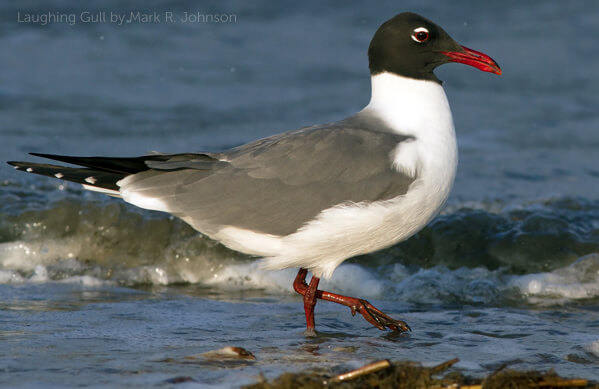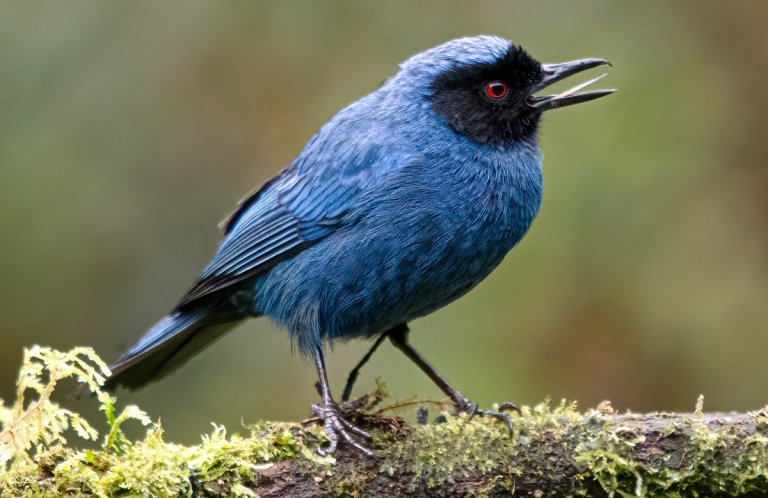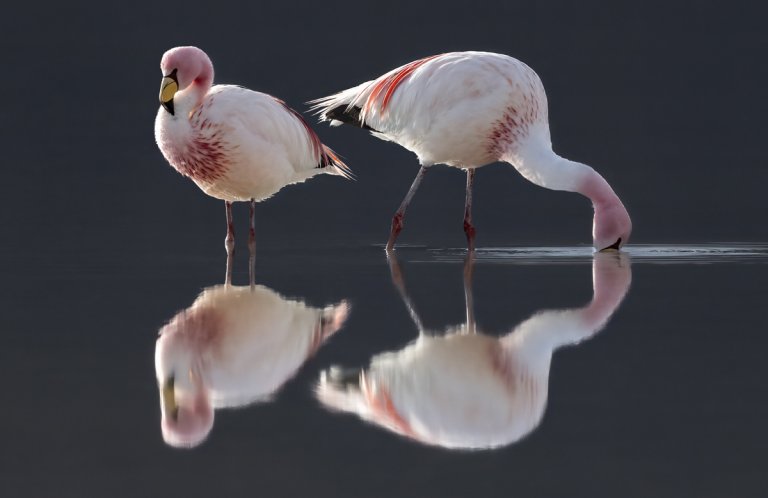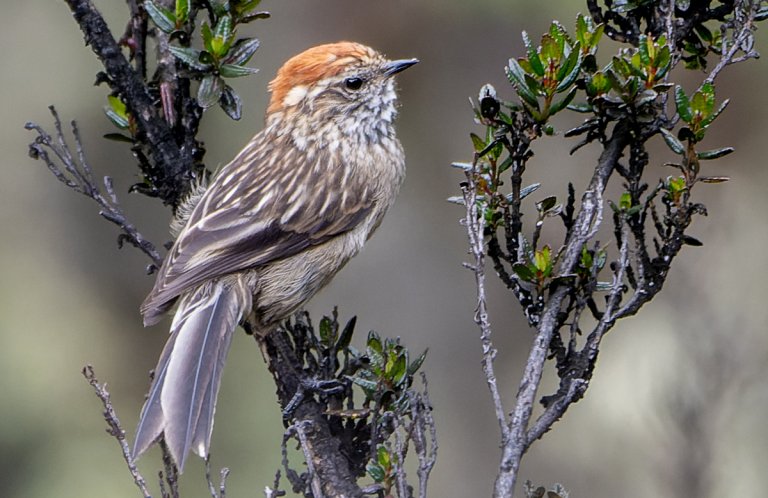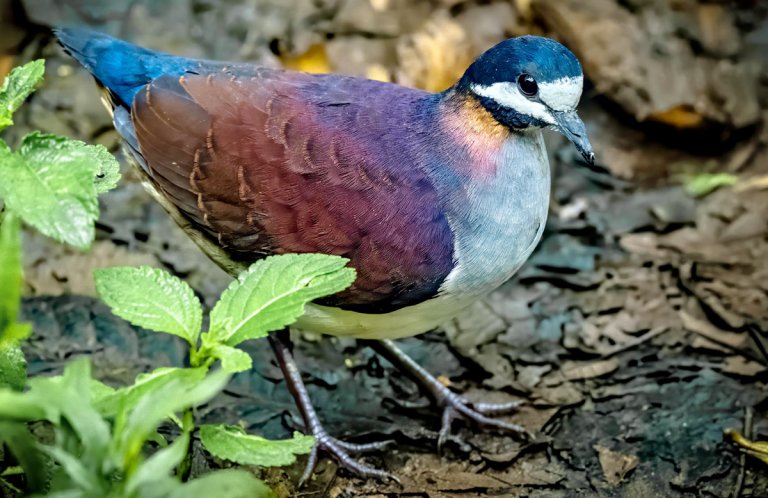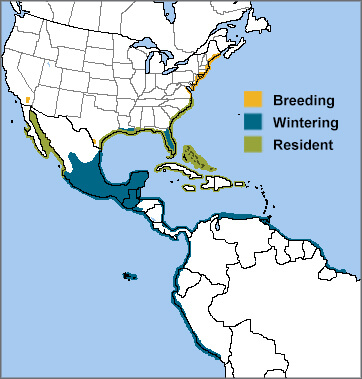
Laughing Gull range map by ABC
The Laughing Gull is perfectly named; its continuous, raucous "ha-ha-ha" calls are a part of the summer soundtrack along Gulf and Atlantic Coast beaches. This medium-sized, black-hooded gull favors the ocean shore and is a common sight there during the summer, alongside other coastal bird species such as the Royal Tern and Piping Plover. It is less common along inland waterways.
Unlike many coast-nesting birds, the Laughing Gull seems to thrive in human company.
Boardwalk Poser
The Laughing Gull has adapted well to changes to its coastline habitat because, like humans, it's social, adaptable, and inventive. This handsome gull, with its black head, reddish bill, dark-gray wings, and gleaming white underparts, tail, and neck, frequents artificial spoil islands, where it readily nests, and landfills and dumpsters, where it scavenges for food. It also feeds on bait and fish offal thrown from fishing boats and docks, and follows plows and other farm equipment to feed on insects and worms stirred up by the machinery.
Like many a summer beachgoer, the Laughing Gull seems to enjoy the bustle of a crowded boardwalk, although its idea of people-watching is more practical than born of curiosity. It can often be seen standing on the ground or atop nearby buildings, from which it swoops in to snack on fries, funnel cake, and other delicacies, sometimes even snatching food from unsuspecting passersby.
Summer-loving Gull
The Laughing Gull breeds along the Atlantic and Gulf Coasts of North America, in the Caribbean, and sparingly along Mexico's Pacific coastline. It is a partial migrant: In the fall, northern populations gather in small flocks and begin to move south to warmer climes for the winter, while Laughing Gulls in Florida and south are generally nonmigratory.
The Laughing Gull is a noisy bird. Its most familiar vocalization is a call reminiscent of human laughter: "ha-ha-ha-ha-haah-haah-haah-ha-ha-ha."
Listen here:
(Audio: Peter Boesman, XC224822. Accessible at www.xeno-canto.org/224822)
A Cornucopia of Comestibles
Much of the Laughing Gull's success is due to its omnivorous diet and adaptable feeding style. Its natural foods include a variety of insects, fish, shellfish, crabs, and sometimes the eggs and young of other birds (including other Laughing Gulls). It steals other birds' food when the opportunity arises, and often lands on the back or head of a foraging Brown Pelican to snatch fish from the larger bird. And, as described above, the Laughing Gull is always ready to scavenge food from humans.
During spring migration, Laughing Gulls moving north along the Atlantic Coast take advantage of annual horseshoe crab spawning, feasting upon this arthropod's nutritious eggs alongside the Red Knot, Sanderling, Ruddy Turnstone, and many other birds.
This adaptable gull forages in a wide variety of ways: walking along the ground; wading in shallow water; gliding over the water to pick prey from the surface (somewhat like a Black Skimmer); or making shallow dives from the water's surface. It also hawks insects in the manner of an American Kestrel or Purple Martin.
Nesting in Numbers
The Laughing Gull usually breeds in large colonies, which at times number in the tens of thousands, sometimes in the company of other water- and shorebirds such as the Least Tern and American Oystercatcher. It adapts its nesting site to local (and available) habitats, favoring low, vegetated islands near the shore. Both male and female build the platform-like nest of grass and sticks in a simple scrape on the ground, ideally concealed among taller vegetation. The pair may continue adding material to the nest while brooding, especially if flooding or high tides threaten to swamp the colony.
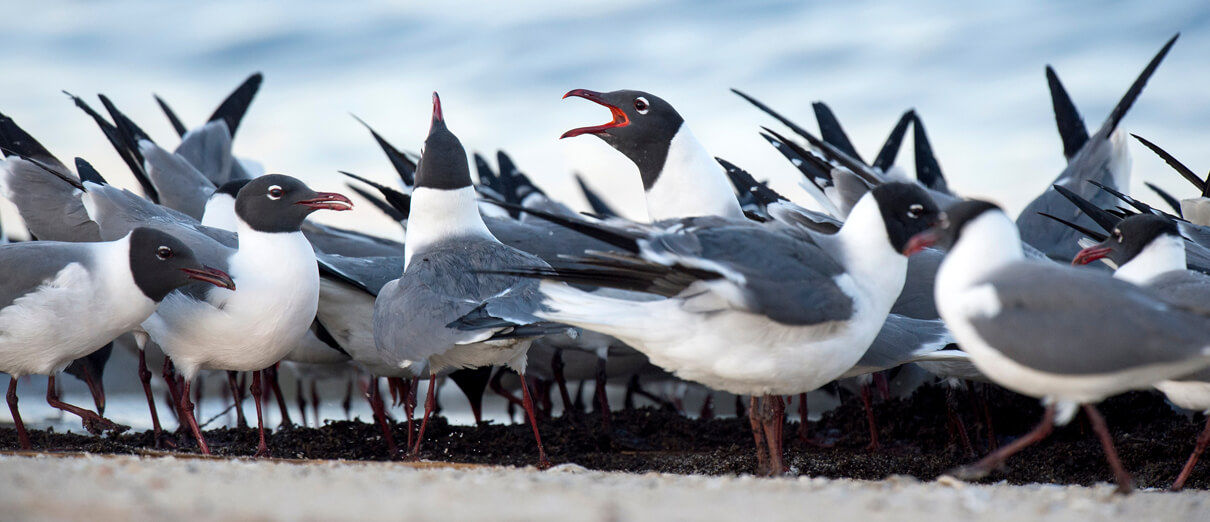
Laughing Gull flock by Ray Hennessy, Shutterstock
Once the female Laughing Gull lays her clutch of one to three eggs, she and her mate take turns incubating. After they hatch, the fuzzy, spotted chicks can move around almost immediately but remain close to the nest. There, they are cared for by both parents until they are able to fly and feed themselves. Once the young fledge, mixed groups of adults and young disperse from the colony.
Laughing Gulls take three years to reach full adult coloration. Before they get there, they cycle through four distinct plumages: juvenile, first winter, first summer, and second winter. Adults also change some of their coloration each year: By summer's end, they have molted into nonbreeding plumage, trading the crisp black head and reddish bill color for a white head with gray smudges and a black bill. By March the next year, they are back in breeding plumage.
Common, with Caveats
Along with Great and Reddish Egrets and many other birds, the Laughing Gull was indiscriminately hunted in the late 19th century for its feathers and eggs. Once laws to protect birds were put into place, Laughing Gull populations rebounded. Today, in many areas, this species' numbers are increasing, likely due to its ability to thrive in human-altered environments.
However common, the Laughing Gull is still vulnerable to destruction of its coastal habitat by development and the increased flooding caused by climate change. Breeding colonies tend to be localized and can be easily disrupted by people walking and driving on the beach, or by off-leash dogs and free-roaming cats. This gull's wide-ranging feeding habitats often expose it to toxic pesticides and oil, particularly along the Gulf Coast. Laughing Gulls from colonies close to airports, especially those around New York City's John F. Kennedy International Airport, are often killed in collisions with airplanes.
ABC launched a Gulf Coast conservation effort in 2012 to identify and implement protective measures for beach-nesting birds. Actions taken include posting signs and installing fencing at coastal colonies to reduce detrimental human recreation impacts that can lead to abandonment or nesting failures. ABC also promotes the "Fish, Swim, and Play from 50 Yards Away" program each year, which aims to educate tourists and local residents about the needs of beach-nesting birds along the Gulf Coast.
ABC's Pesticides program also works to control toxic pollutants that threaten many bird species.
Donate to support ABC's conservation mission!





































